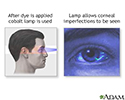Fluorescein eye stain
This is a test that uses orange dye (fluorescein) and a blue light to detect foreign bodies in the eye. This test can also detect damage to the cornea. The cornea is the outer surface of the eye.
A piece of blotting paper containing the dye is touched to the surface of your eye. You are asked to blink. Blinking spreads the dye and coats the tear film covering the surface of the cornea. The tear film contains water, oil, and mucus to protect and lubricate the eye.
The health care provider then shines a blue light at your eye. Any problems on the surface of the cornea will be stained by the dye and appear green under the blue light.
The provider can determine the location and likely cause of the cornea problem depending on the size, location, and shape of the staining.
How to Prepare for the Test
You will need to remove your eyeglasses or contact lenses before the test.
How the Test will Feel
If your eyes are very dry, the blotting paper may be slightly scratchy. The dye may cause a mild and brief stinging sensation.
Why the Test is Performed
This test is to:
- Find scratches or other problems with the surface of the cornea
- Reveal foreign bodies on the eye surface
- Determine if there is irritation of the cornea after contacts are prescribed
Normal Results
If the test result is normal, the dye remains in the tear film on the surface of the eye and does not stick to the eye itself.
What Abnormal Results Mean
Abnormal results may point to:
- Abnormal tear production (dry eye)
- Blocked tear duct
- Corneal abrasion (a scratch on the surface of the cornea)
- Foreign bodies, such as eyelashes or dust (foreign object in eye)
- Infection
- Injury or trauma
- Severe dry eye associated with arthritis (keratoconjunctivitis sicca)
Risks
If the dye touches the skin, there may be a slight, brief, discoloration.
References
Fowler GC. Corneal abrasions and removal of corneal or conjunctival foreign bodies. In: Fowler GC, ed. Pfenninger and Fowler's Procedures for Primary Care. 4th ed. Philadelphia, PA: Elsevier; 2020:chap 200.
Review Date: 1/16/2021
Reviewed By: Linda J. Vorvick, MD, Clinical Associate Professor, Department of Family Medicine, UW Medicine, School of Medicine, University of Washington, Seattle, WA. Also reviewed by David Zieve, MD, MHA, Medical Director, Brenda Conaway, Editorial Director, and the A.D.A.M. Editorial team.





